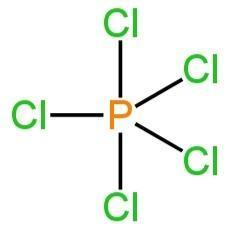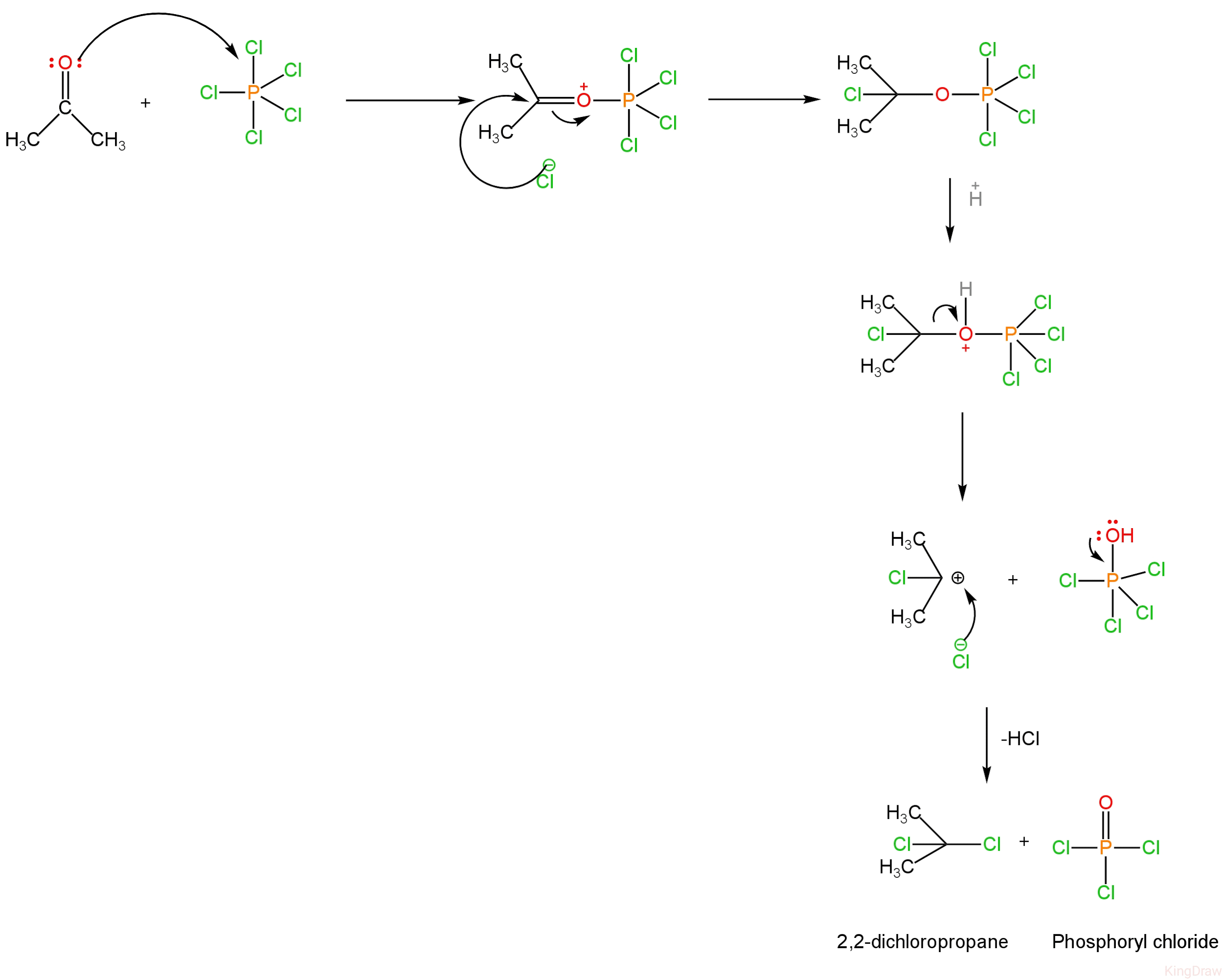
\[PC{l_5}\] reacts with propanone, to give
A. Vicinal dichloride
B. Propanal
C. propane chloride
D. Gem-dichloride
Answer
221.1k+ views
Hint: Phosphorus pentachloride is the name of the chemical compound PCl₅. It is a significant phosphorus chloride and is used as a chlorinating reagent. When this compound is treated with ketones, chlorination transpires at the carbonyl carbon.
Complete Step by Step Solution:
Phosphorus pentachloride is the chemical compound possessing the formula PCl5.
It is one of the considerably crucial phosphorus chlorides alongside\[PC{l_3}\] and\[POC{l_3}\].
\[PC{l_5}\] is utilised as a chlorinating reagent.
It has no colour and is sensitive to moisture and water.
Its structure is as follows:

Image: Structure of phosphorus pentachloride
When it reacts with carbonyl groups like in ketones it leads to the conversion of C=O groups to \[CC{l_2}\]groups.
So, when it reacts with propanone it converts the C=O group to the CCl2 group.
Mechanism
1. The lone pair of oxygen in the carbonyl group attacks the phosphorus atom present in phosphorus pentachloride leading to the formation of a complex.
2. The complex formed when treated with a proton leads to the breaking of the carbon and oxygen bond. A carbocation is formed.
3. Carbocation is attacked by chloride ions present in the medium forming 2,2-dichloropropane and Phosphoryl chloride along with it which is a side product.

Image: Mechanism of chlorination of propanone.
As we know, 2,2-dichloropropane is a gem-dichloride. So, D is correct.
So, option D is correct.
Note: Phosphorus pentachloride also transforms alcohols into alkyl chlorides. This reaction is used in the preparation of alkyl chlorides. But thionyl chloride is more generally utilised in the laboratory as the resultant sulphur dioxide is a gas, and hence is more effortlessly isolated from the organic products than \[POC{l_3}\].
Complete Step by Step Solution:
Phosphorus pentachloride is the chemical compound possessing the formula PCl5.
It is one of the considerably crucial phosphorus chlorides alongside\[PC{l_3}\] and\[POC{l_3}\].
\[PC{l_5}\] is utilised as a chlorinating reagent.
It has no colour and is sensitive to moisture and water.
Its structure is as follows:

Image: Structure of phosphorus pentachloride
When it reacts with carbonyl groups like in ketones it leads to the conversion of C=O groups to \[CC{l_2}\]groups.
So, when it reacts with propanone it converts the C=O group to the CCl2 group.
Mechanism
1. The lone pair of oxygen in the carbonyl group attacks the phosphorus atom present in phosphorus pentachloride leading to the formation of a complex.
2. The complex formed when treated with a proton leads to the breaking of the carbon and oxygen bond. A carbocation is formed.
3. Carbocation is attacked by chloride ions present in the medium forming 2,2-dichloropropane and Phosphoryl chloride along with it which is a side product.

Image: Mechanism of chlorination of propanone.
As we know, 2,2-dichloropropane is a gem-dichloride. So, D is correct.
So, option D is correct.
Note: Phosphorus pentachloride also transforms alcohols into alkyl chlorides. This reaction is used in the preparation of alkyl chlorides. But thionyl chloride is more generally utilised in the laboratory as the resultant sulphur dioxide is a gas, and hence is more effortlessly isolated from the organic products than \[POC{l_3}\].
Recently Updated Pages
Difference Between Alcohol and Phenol: Structure, Tests & Uses

Classification of Drugs in Chemistry: Types, Examples & Exam Guide

Class 12 Chemistry Mock Test Series for JEE Main – Free Online Practice

Is PPh3 a strong ligand class 12 chemistry JEE_Main

Full name of DDT is A 111trichloro22bispchlorophenyl class 12 chemistry JEE_Main

Sodium acetate on heating with soda lime produce A class 12 chemistry JEE_Main

Trending doubts
JEE Main 2026: Application Form Open, Exam Dates, Syllabus, Eligibility & Question Papers

Derivation of Equation of Trajectory Explained for Students

Hybridisation in Chemistry – Concept, Types & Applications

Understanding the Angle of Deviation in a Prism

How to Convert a Galvanometer into an Ammeter or Voltmeter

Degree of Dissociation: Meaning, Formula, Calculation & Uses

Other Pages
Solutions Class 12 Chemistry Chapter 1 CBSE Notes - 2025-26

NCERT Solutions For Class 12 Chemistry Chapter 1 Solutions - 2025-26

The D and F Block Elements Class 12 Chemistry Chapter 4 CBSE Notes - 2025-26

NCERT Solutions for Class 12 Chemistry Chapter Chapter 7 Alcohol Phenol and Ether

NCERT Solutions ForClass 12 Chemistry Chapter Chapter 8 Aldehydes Ketones And Carboxylic Acids

JEE Advanced Marks vs Ranks 2025: Understanding Category-wise Qualifying Marks and Previous Year Cut-offs




